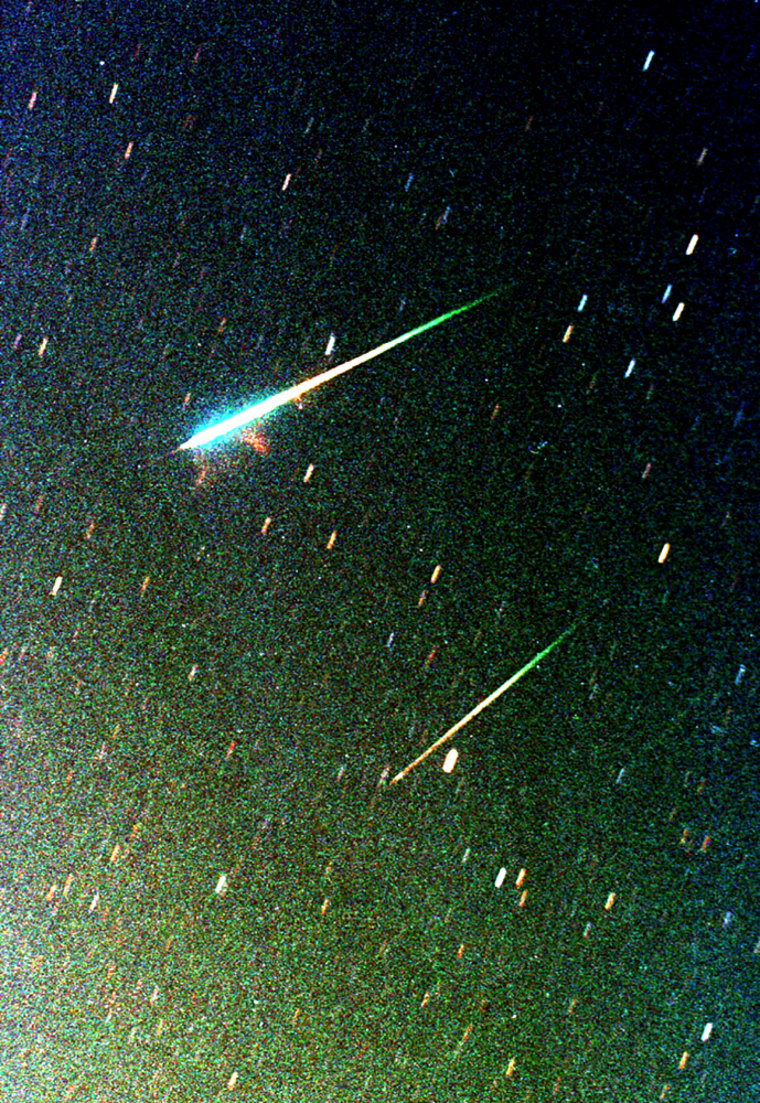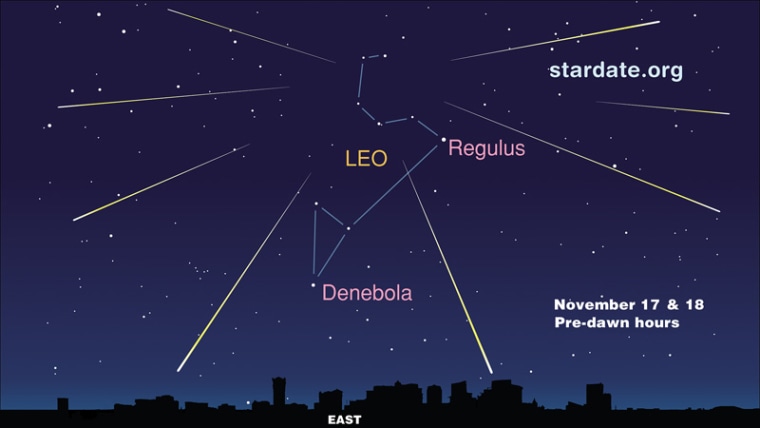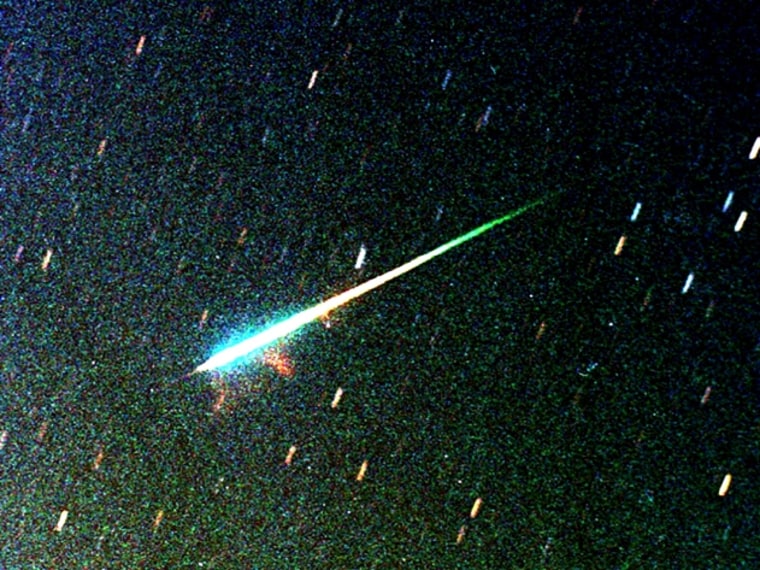
The annual Leonid meteor shower reaches its peak this weekend — and the Internet provides lots of ways to put some spice into what otherwise would be a lackluster year for shooting stars.
Let's accept the fact that the Leonids don't produce as many fireworks as they did in the peak years of 1998-2002. And let's accept the fact that the full moon's glare will interfere with this year's show. Now let's look at the bright side: If the skies are clear during the peak viewing times, just before dawn on Sunday and Monday morning, you just might see a comet or two in addition to the Leonid meteor streaks.
The wee hours of the morning are best for a couple of reasons. First of all, that's the time when Earth is turning more directly into the flux of space grit left behind by Comet Tempel-Tuttle. Meteor showers are sparked when our planet passes through such trails of cometary debris. When those cosmic bits of grit and gravel slam through the upper atmosphere, they leave a glowing streak of ionized dust and gas that we see as a meteor.
Leonids are so named because they appear to radiate from the constellation Leo. During the predawn hours, the radiant is high up in the eastern sky. That's a good place to look for another reason: If you're facing east, the moon is behind you, slowly sinking toward the western horizon. You won't be staring right into the full moon's glare. It's even better if your vantage point has high hills or buildings to the west, blocking that meddlesome moonglow.
Even under peak conditions, you might see no more than 10 meteors per hour — which sounds paltry compared with the peak rates of 100 per hour for August's Perseid meteor shower. But the possibility of spotting Comet ISON and Comet Lovejoy is an extra perk.

To see ISON, try looking around Spica, the bright star near the southeast horizon, for a fuzzy greenish glow. Lovejoy is sitting higher up in the sky, above the top of the constellation Leo. A pair of binoculars or a telescope comes in handy for comet viewing, even though they're not needed for meteor watching. These sky charts and the Comet Watch app for iPhone and iPad might come in handy as well.
If you're in the right place at the right time, you might also spot the International Space Station passing overhead. Some locations offer multiple opportunities for seeing the space station's bright speck early Sunday and Monday. Check NASA's "Spot the Station" website to get the times and trajectories for your locale.
Here's a top-ten list of tips for making the most of even a mediocre meteor shower:
1. Pick a viewing spot far away from city lights, where the skies are likely to be clear and wide-open. Higher elevations are usually better than lower elevations. For help in site selection, check out the Clear Sky Chart website, which provides weather conditions for skywatching ... and links to popular viewing locations on a state-by-state basis. Your local astronomy club can also point you in the right direction.
2. Bring a blanket or a chaise lounge to lie back on. Dress in layers to ward off the night's chill. Bring snacks and drinks. (A thermos comes in handy here.) Bring a flashlight so you can find your way through the dark.
3. Bring a music player or radio if you need a diversion. But don't forget the earphones if you're going to be alongside other groups who may not appreciate your musical taste. Frankly, the best diversion is a deep philosophical conversation with your meteor-watching friends.
4. Don't give up too quickly. Give your eyes plenty of time to get accustomed to the dark. Although the meteors appear to emanate from the radiant in Leo, don't focus exclusively on that point.
5. The later you can stay up, the better. Generally speaking, meteor shows don't get good until after midnight, when Earth is turning into the stream of meteor debris.
6. To get a better sense of what to expect at which time, use NASA's Fluxtimator. When you click in the right coordinates for meteor shower, date, location and viewing conditions, the Java-based calculator charts what the estimated meteor flux will be at different times.
7. If you're totally clouded out, you can try watching or listening to the meteors online. During the height of the meteor shower on Saturday night and Sunday morning, NASA's Leonid website will link to a Ustream video feed from Marshall Space Flight Center, showing the skies over Huntsville, Ala. (If you're checking out the feed during off-hours, you might get alternate programming.) Meanwhile, SpaceWeather Radio offers a real-time audio feed of meteor radar echoes. Here's a spooky audio file that gives you an idea what the echoes sound like.
8. The Slooh virtual observatory is planning a webcast about the Leonids airing from 8 p.m. to 11:45 p.m. ET Sunday, with all-sky views from its observatory in the Canary Islands and commentary from astronomer Bob Berman. The Leonid show will be followed by a Slooh broadcast about Comet ISON. You can watch via Slooh's website, its iPad app or its YouTube channel. To make it easier for you, we've embedded the YouTube video frame right here.
9. If you want to share your meteor sightings with the world via Twitter — and find out where the sightings are sizzling — use the hashtag #Meteorwatch on Twitter, or check the MeteorWatch website.
10. Even if you miss the meteor shower completely, you can click through the gallery of greatest hits at SpaceWeather.com. And you can start making plans for the Geminids (peaking Dec. 13-14), when the moon conditions will be better.
More about meteors:
- The scientific story behind meteor shows
- Flash interactive: What sparks meteors?
- NBC News archive on meteors
Alan Boyle is NBCNews.com's science editor. Connect with the Cosmic Log community by "liking" the log's Facebook page, following @b0yle on Twitter and adding the Cosmic Log page to your Google+ presence. To keep up with Cosmic Log as well as NBCNews.com's other stories about science and space, sign up for the Tech & Science newsletter, delivered to your email in-box every weekday. You can also check out "The Case for Pluto," my book about the controversial dwarf planet and the search for new worlds.
